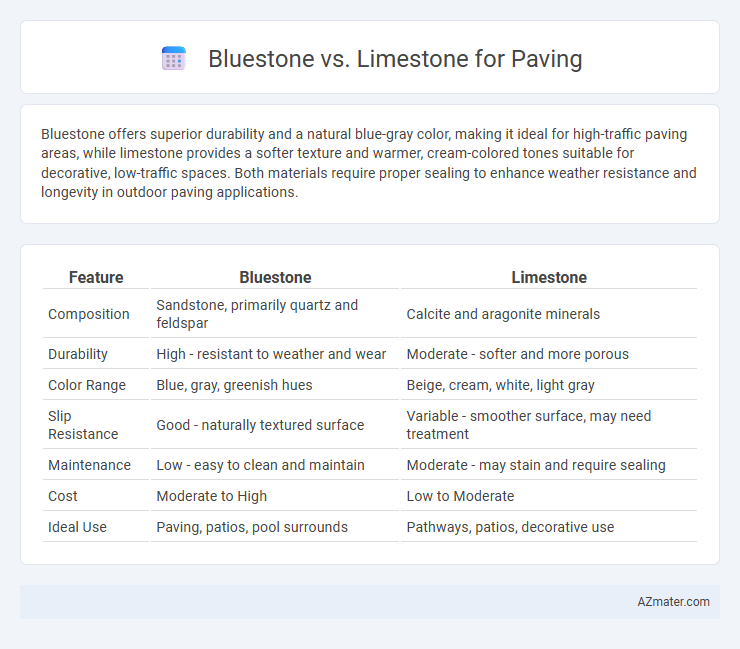Bluestone offers superior durability and a natural blue-gray color, making it ideal for high-traffic paving areas, while limestone provides a softer texture and warmer, cream-colored tones suitable for decorative, low-traffic spaces. Both materials require proper sealing to enhance weather resistance and longevity in outdoor paving applications.
Table of Comparison
| Feature | Bluestone | Limestone |
|---|---|---|
| Composition | Sandstone, primarily quartz and feldspar | Calcite and aragonite minerals |
| Durability | High - resistant to weather and wear | Moderate - softer and more porous |
| Color Range | Blue, gray, greenish hues | Beige, cream, white, light gray |
| Slip Resistance | Good - naturally textured surface | Variable - smoother surface, may need treatment |
| Maintenance | Low - easy to clean and maintain | Moderate - may stain and require sealing |
| Cost | Moderate to High | Low to Moderate |
| Ideal Use | Paving, patios, pool surrounds | Pathways, patios, decorative use |
Overview of Bluestone and Limestone
Bluestone is a dense, fine-grained sandstone known for its durability and rich blue-gray hues, often used in outdoor paving for its slip-resistant surface and resistance to weathering. Limestone, a sedimentary rock primarily composed of calcium carbonate, offers a softer, warm beige to gray color palette, favored for its smooth texture and ease of cutting and shaping in paving projects. Both materials provide distinct aesthetic and functional qualities, with bluestone excelling in high-traffic areas and limestone preferred for decorative, low-impact environments.
Key Differences Between Bluestone and Limestone
Bluestone features a dense, fine-grained texture with a natural blue-grey hue, making it highly durable and slip-resistant for paving applications, while limestone generally exhibits a lighter color range from creamy white to earthy tones with a softer, more porous structure prone to weathering. Bluestone originates primarily from sandstone deposits, offering greater hardness and resistance to abrasion compared to limestone, which is a sedimentary rock composed mostly of calcite and reacts more readily to acids. These key differences affect their suitability for paving, where bluestone is favored for heavy-traffic areas and outdoor patios requiring robustness, whereas limestone suits decorative or indoor uses needing smoother finishes.
Aesthetic Appeal and Color Variations
Bluestone offers a rich, natural blue-gray hue that deepens when wet, providing a sophisticated and timeless aesthetic for paving projects. Limestone presents a warm, creamy palette with subtle earth tones ranging from beige to soft yellows, creating a classic and inviting appearance. The distinct color variations in Bluestone emphasize texture and depth, while Limestone's uniform shades lend a smooth, elegant surface ideal for diverse landscape designs.
Durability and Weather Resistance
Bluestone boasts superior durability and weather resistance compared to limestone, making it ideal for paving in climates with extreme temperature variations and heavy rainfall. Its dense composition resists cracking, chipping, and erosion, ensuring long-lasting performance and minimal maintenance. Limestone, while aesthetically pleasing, tends to be more porous and susceptible to weather-induced wear, limiting its effectiveness in harsh environmental conditions.
Slip Resistance and Safety
Bluestone offers superior slip resistance compared to limestone due to its naturally textured surface, making it an ideal choice for high-traffic paving areas where safety is a priority. Limestone tends to be smoother and can become slippery when wet, increasing the risk of slips and falls. Selecting Bluestone enhances pedestrian safety by providing better traction in diverse weather conditions.
Maintenance Requirements
Bluestone paving requires regular sealing to prevent staining and weather damage, and its porous nature demands periodic cleaning to avoid moss and algae buildup. Limestone paving, being softer and more susceptible to scratching and acid rain erosion, necessitates gentle cleaning methods and more frequent resealing to maintain its surface integrity. Both materials benefit from prompt stain removal and controlled exposure to harsh chemicals to extend their lifespan and aesthetic appeal.
Cost Comparison
Bluestone paving typically costs between $15 and $30 per square foot, reflecting its durability and natural aesthetics, while limestone ranges from $10 to $25 per square foot, offering a more budget-friendly option. Installation costs for both materials can vary, with bluestone often requiring specialized labor due to its hardness, potentially increasing expenses compared to the easier-to-cut limestone. Homeowners should consider long-term maintenance costs, as bluestone's density generally results in less wear and lower upkeep over time compared to limestone.
Environmental Impact
Bluestone and limestone differ significantly in their environmental impact for paving projects, with bluestone being a more sustainable choice due to its natural durability and minimal processing requirements. Limestone extraction often involves energy-intensive quarrying and can result in higher carbon emissions and habitat disruption compared to bluestone. Recyclability and longevity also favor bluestone, reducing the need for frequent replacement and lowering long-term ecological footprints.
Installation and Workability
Bluestone offers greater durability and requires fewer joints during paving installation, making it ideal for heavy-traffic areas, while limestone is softer and easier to cut, providing more flexibility for intricate designs. The workability of limestone simplifies the laying process, reducing labor time and costs, whereas bluestone's density demands specialized tools and skilled labor for precise fitting. Choosing between bluestone and limestone balances installation complexity with the desired longevity and aesthetic of the paved area.
Best Applications for Each Stone
Bluestone is ideal for outdoor paving projects requiring durability and slip resistance, such as patios, walkways, and pool surrounds, due to its dense structure and natural cleft surface. Limestone, with its softer texture and warm hues, suits indoor flooring and decorative pathways where aesthetic appeal and a smooth finish are prioritized over heavy foot traffic resistance. Both stones offer unique benefits: bluestone excels in harsh weather environments while limestone enhances interior spaces with elegant, timeless charm.

Infographic: Bluestone vs Limestone for Paving
 azmater.com
azmater.com